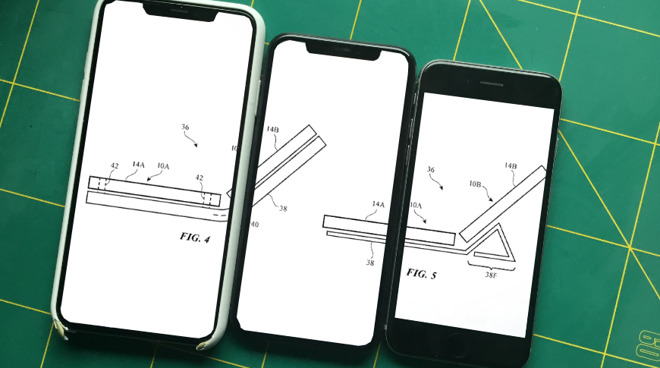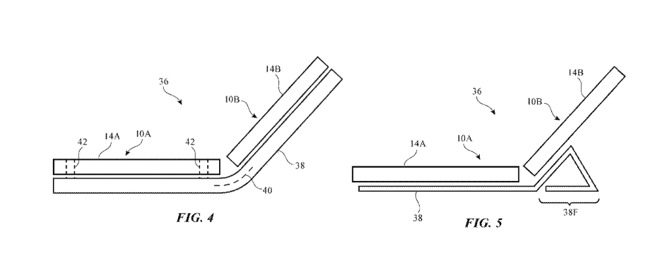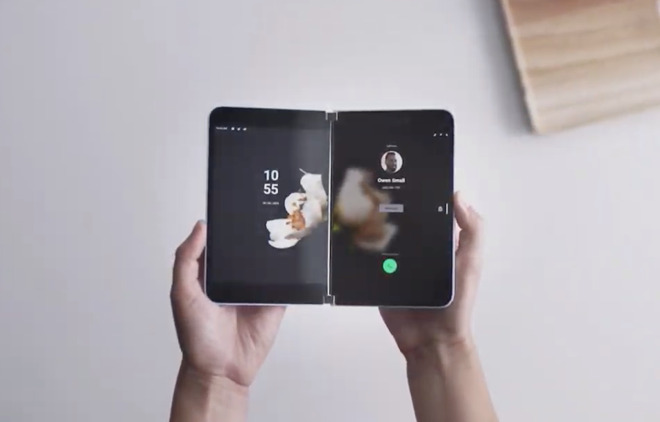Apple's foldable iPhone may not need a hinge under the screen
Apple is working on technology for two or more devices to act in concert when close together, with the technology able to make a foldable iPhone that doesn't suffer from a bending screen.

Future iPhones, or other Apple devices, could automatically detect when they're in close proximity, and then share a common display image across all of them
Following Apple's previous patent applications regarding "wraparound" multiple displays for iPhones, a new one details possible future devices that share screens. They may automatically register each other's presence, and immediately begin to work together.
Using the technology, a series of iPhones or iPads might be used to display a single video wall across all their screens, for instance. However, Apple also describes how two iPhones could be connected in this way to effectively produce one bendable device.
The example drawings in "System with multiple electronic devices", US Patent No 10,585,708, also show a familiar iPad-style Smart Cover being used to house such a device.
"Electronic devices such as cellular telephones are often used in isolation,"says the patent. "[However, using] devices in isolation can be unsatisfactory. For example, devices that operate independently are not able to help each other when presenting a video or book to a user."
Apple describes how devices could be made that contain sensors to register when they are in close proximity. Placing two, or more, next to each other could be enough to trigger them working in concert. Equally, then simply picking up one device could be enough to make them all revert to working independently.
"Multiple electronic devices may be used together in a system," continues the patent. "The electronic devices may use sensor measurements and other information to detect when an edge of a first electronic device is adjacent to an edge of a second electronic device."

Detail from the patent applications drawings. Notice the Smart Cover-like image in the right hand drawing.
"In the joint operating mode," it continues, "images may extend across displays in the devices, speakers in the devices may be used to play different channels of an audio track, cameras and other sensors may be used in cooperation with each other, and other resources may be shared."
Apple suggests that "magnetic components may hold devices together in a variety of orientations," and certain of the orientations it describes fit with the idea of a bendable device.
Such a device could comprise two completely independent iPhones which act in concert only because they are housed close together in a foldable or bendable cover. Alternatively, one device might contain a touch display while the other contains storage or further processing capabilities.
"[Both may] be cellular telephones, may both be wristwatch devices, may both be tablet computers, may both be laptop computers, may both be desktop computers, etc," continues the patent, "[or they] may be different types of devices. For example... a tablet computer and... a cellular telephone.
The technology is not dissimilar to that of the Surface Duo, expected to ship at some point in 2020. For that device, the "hinge" area is a bezel, and is used to implement user interface gestures.

The patent application is credited to two inventors, James R. Wilson, and David A. Pakula. Between them, they hold over 120 patents, many to do with displays on electronic devices. Wilson was recently credited on a patent regarding how Apple glasses could have hidden cameras and removable headphones.

Future iPhones, or other Apple devices, could automatically detect when they're in close proximity, and then share a common display image across all of them
Following Apple's previous patent applications regarding "wraparound" multiple displays for iPhones, a new one details possible future devices that share screens. They may automatically register each other's presence, and immediately begin to work together.
Using the technology, a series of iPhones or iPads might be used to display a single video wall across all their screens, for instance. However, Apple also describes how two iPhones could be connected in this way to effectively produce one bendable device.
The example drawings in "System with multiple electronic devices", US Patent No 10,585,708, also show a familiar iPad-style Smart Cover being used to house such a device.
"Electronic devices such as cellular telephones are often used in isolation,"says the patent. "[However, using] devices in isolation can be unsatisfactory. For example, devices that operate independently are not able to help each other when presenting a video or book to a user."
Apple describes how devices could be made that contain sensors to register when they are in close proximity. Placing two, or more, next to each other could be enough to trigger them working in concert. Equally, then simply picking up one device could be enough to make them all revert to working independently.
"Multiple electronic devices may be used together in a system," continues the patent. "The electronic devices may use sensor measurements and other information to detect when an edge of a first electronic device is adjacent to an edge of a second electronic device."

Detail from the patent applications drawings. Notice the Smart Cover-like image in the right hand drawing.
"In the joint operating mode," it continues, "images may extend across displays in the devices, speakers in the devices may be used to play different channels of an audio track, cameras and other sensors may be used in cooperation with each other, and other resources may be shared."
Apple suggests that "magnetic components may hold devices together in a variety of orientations," and certain of the orientations it describes fit with the idea of a bendable device.
Such a device could comprise two completely independent iPhones which act in concert only because they are housed close together in a foldable or bendable cover. Alternatively, one device might contain a touch display while the other contains storage or further processing capabilities.
"[Both may] be cellular telephones, may both be wristwatch devices, may both be tablet computers, may both be laptop computers, may both be desktop computers, etc," continues the patent, "[or they] may be different types of devices. For example... a tablet computer and... a cellular telephone.
The technology is not dissimilar to that of the Surface Duo, expected to ship at some point in 2020. For that device, the "hinge" area is a bezel, and is used to implement user interface gestures.

The patent application is credited to two inventors, James R. Wilson, and David A. Pakula. Between them, they hold over 120 patents, many to do with displays on electronic devices. Wilson was recently credited on a patent regarding how Apple glasses could have hidden cameras and removable headphones.

Comments
I think the benefits of two screens with a small line between them far outweighs any advantages a folding screen could have.
Apple - Will it fold?
My John Oliver impression...
Last week Samsung introduced a future-thinking folding phone. Future-thinking in that nobody at present can think of a single reason why we’d want a phone that when folded has a small narrow display and is nearly two and a half times thicker than an iPhone. Future-thinking in that someone, someday, might think of a reason we want a small square tablet with a screen that when touched reminds us of a giant 1980’s membrane switch.
I know, I know, my Apple wool is preventing me from seeing the brilliance of Samsung’s move. All I’m able to perceive here is an attempt to be first. On that score Samsung has won yet another round, another pyrrhic victory for their side of the ledger. And yes, Apple may follow, but not down the same trail Samsung is blazing. For Apple to offer a foldable phone, there still exists some real challenges:
Appropriate hardware technology would have to be available.
First, the display would need to be covered with a non-malleable and scratch-resistant surface; there’s little chance Apple would return to a malleable and markable, plastic display cover. The challenge is that the necessary display properties are, of course, incompatible with folding and are likely to remain so.
Next, the phone when folded will need to be as ready to hand, and pocket, as current iPhones, to which any foldable iPhone, in folded configuration, will be ruthlessly compared. The rumor that Apple may bolster battery capacity in the 2019 models could result in thicker iPhones, which would help in a comparison of a future foldable model. Apple would be setting the stage for a thicker handset with a meaningful enhancement to justify it. But it would still be a significant challenge to then add a second screen layer and not significantly increase the thickness. Perhaps a flattened battery on one side of the fold and all the electronics and cameras on the other fold. Not sure if Samsung did that, or if it’s even viable.
Next there’s the reliability aspect. iPhones, and high-end Android phones, are all very solidly constructed these days, with few or no moving parts. But that doesn’t imply even today’s phones are free of physical wear and tear or immune to extreme conditions. Extreme cold or heat will be significant issues to account for in selecting materials and designing folding phones to yield a similar lifespan compared to their non-folding counterparts. For iPhones that implies a five- or six-year lifespan. Not to mention tensile stresses of the folding process itself.
The only viable solution my limited brain can conceive is two separate displays, each pressed up hard against a lip on a hinge to prevent dust or cookie crumbs intruding. As the phone unfolds, at the last part of the arc, that lip recedes, allowing the two screen edges to come together perfectly, leaving not a single pixel width gap between. How incredibly precise would such a mechanism need to be... boggles the mind. But if it worked, every time, for five or six years, it would allow two glass-covered displays to perfectly come together as one, without a visible seam.
Finally, Apple would need to do one more thing that Samsung has not yet accomplished. Apple would need to determine the reason such a needlessly complex handset should exist. That’s where I take my bet off the table. I’m betting Apple goes a different direction.
Maybe you could have an accessory (shaped like an iPhone) that connects to the existing iPhone, which extends the screen size. But, is it really worth the bother? You can do something similar with AirPlay already if you want to view things on a larger screen.